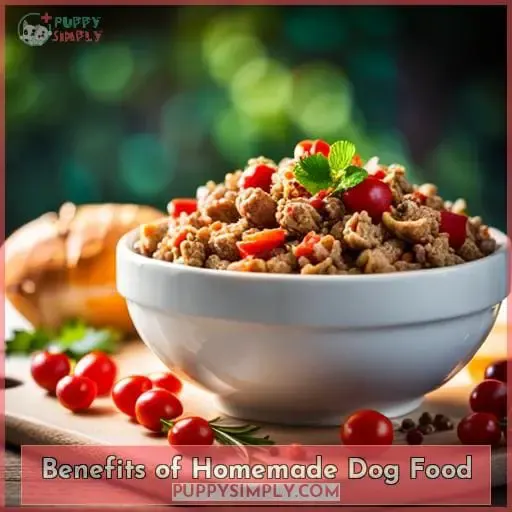This site is supported by our readers. We may earn a commission, at no cost to you, if you purchase through links.
 Discover the benefits, ingredients, and cooking process of homemade greyhound dog food.
Discover the benefits, ingredients, and cooking process of homemade greyhound dog food.
If you’re looking to provide your beloved greyhound with a nutritious diet tailored to their specific needs, this article is for you. Learn why homemade dog food can be beneficial for dogs with sensitive stomachs or compromised immune systems.
Explore the anatomical basis behind a homecooked diet and find out which essential ingredients should be included in your pup’s meals.
Table Of Contents
- Key Takeaways
- Benefits of Homemade Dog Food
- Anatomical Basis for a Homecooked Dog Diet
- Ingredients for a Homecooked Dog Food Diet
- Where to Buy Ingredients for a Homecooked Dog Food Diet
- How to Cook a Homecooked Dog Food Diet
- Frequently Asked Questions (FAQs)
- Can I feed my greyhound a raw food diet?
- Are vitamin supplements necessary for my greyhound’s homemade diet?
- Should I consult a nutritionist about my greyhound’s homemade diet?
- Should I incorporate more animal parts in my greyhound’s food?
- How can I ensure my greyhound is getting all the necessary nutrients from a homemade diet?
- Conclusion
Key Takeaways
- Homemade dog food can be beneficial for greyhounds with sensitive stomachs, compromised immune systems, or active service dogs.
- The anatomical basis for a homecooked dog diet includes replacing bones with bone meal and including specific percentages of different organ meats and vegetables.
- Ingredients for a homemade dog food diet include muscle meat, innards, vegetables, and supplements.
- It is important to buy ingredients from local sources or trusted online suppliers and to cook the food at the appropriate temperature, store leftovers properly, and consult a nutritionist for guidance.
Benefits of Homemade Dog Food
There are several benefits to feeding your greyhound homemade dog food.
- If your dog has a sensitive stomach, a home-cooked diet can help alleviate digestive issues.
- Similarly, dogs with compromised immune systems may benefit from the nutrients provided by a homemade diet.
- Additionally, active service dogs who can’t consume raw diets have the option of being fed nutritious cooked meals instead.
- Lastly, some owners simply prefer cooking for their dogs as it allows them to control the quality and ingredients in their pet’s food.
Sensitive Stomach
If your greyhound has a sensitive stomach, homemade dog food can be beneficial for their digestion.
Dogs with sensitive stomachs may experience issues such as diarrhea or food allergies.
Homemade dog food allows you to control the ingredients and avoid potential triggers.
A bland diet of chicken and rice is often recommended for dogs with sensitive stomachs.
Including vegetables in the homemade diet provides fiber and essential nutrients while probiotics support digestive health.
Always consult your vet before making any changes to your dog’s diet.
Compromised Immune System
For dogs with a compromised immune system, homemade dog food can provide the necessary nutrients to support their health and well-being.
A balanced diet that includes immune-boosting foods such as probiotics and supplements can help strengthen the immune system and reduce the risk of infection.
It’s important to consult with a veterinarian for guidance on formulating an appropriate homemade dog food recipe and transitioning your greyhound to this new diet under veterinary supervision.
Active Service Dogs
When cooking homemade dog food for your active service dog, you can provide them with the nutrients they need to perform their duties effectively.
A cooked food diet tailored specifically for active service dogs can support their:
- Energy levels
- Obedience
- Training
- Socialization
- Overall performance
By including high-quality ingredients and following a balanced recipe that meets their nutritional requirements, you can ensure that your active service dog receives optimal nourishment to thrive in its important role.
Personal Preference
Cooking homemade dog food allows you to customize your greyhound’s diet according to personal preference. This gives you more control over what ingredients are included and excludes any additives or fillers found in commercial dog food.
While it may be more time-consuming and expensive, the benefits of homemade dog food include better quality, fresher ingredients that are less processed. It also allows for a healthier and more customized diet tailored specifically to your greyhound’s needs.
Anatomical Basis for a Homecooked Dog Diet
To ensure that your homemade dog diet meets the anatomical needs of a greyhound, several key factors should be considered.
- First, bones should be replaced with bone meal to provide necessary calcium and phosphorus.
- Second, the diet should contain between 15-25% fat for energy and overall health.
- Third, proportions of organs such as liver, heart, kidney,lung,and spleen (to equal parts) are essential sources of vitamins and minerals.
- Lastly,the inclusion of dog-safe vegetables provides fiber,nutrients,and variety in their diet.
The Anatomical Basis for a Homecooked Dog Diet is crucial in order to meet all nutritional requirements.
Replacement for Bones
To create a homemade diet that meets the anatomical needs of your greyhound, it’s important to find a suitable replacement for bones.
Bones are rich in calcium and provide essential nutrients for dogs. However, instead of using actual bones in their diet, you can opt for bone meal or ground bone as alternatives.
Bone broth can also be incorporated into their meals to ensure they receive the necessary minerals and nutrients.
Additionally, boneless meat can be used as a source of protein without the risk of splintering bones.
Ideal Fat Content
To ensure a balanced and nutritious homemade dog food diet for your greyhound, it’s important to include an ideal fat content of 15-25% in their meals.
Fat plays a crucial role in providing energy and supporting various bodily functions.
Additionally, the diet should consist of:
- 30-40% carbohydrates for sustained energy
- 40-60% vegetables for essential vitamins and minerals, with at least 30-50% being green leafy vegetables rich in antioxidants.
To make up for any potential deficiencies, it’s recommended to incorporate a vitamin B substitute into the diet.
Proportions of Organs
To ensure a balanced and nutritious homecooked diet for your greyhound, it’s important to consider the proportions of organs in their meals.
The ideal ratio is 1/3 liver, 1/3 heart, and 1/3 kidney, lung, and spleen. This provides a variety of essential nutrients that support your dog’s overall health.
Additionally, when including vegetables in their diet, aim for 50% green leafy vegetables to provide necessary vitamins and minerals.
Inclusion of Vegetables
To include vegetables in a greyhound’s homemade diet, aim for a proportion of 40-60% vegetables, with at least 30-50% being green leafy vegetables.
Vegetables are important for digestion and provide essential nutrients. Opt for a variety of types such as broccoli, carrots, spinach, and sweet potatoes to ensure your dog receives a well-rounded diet.
You can choose to feed raw or cooked vegetables depending on your preference and the specific needs of your greyhound.
Ingredients for a Homecooked Dog Food Diet
To create a well-balanced homecooked dog food diet for your greyhound, you’ll need to include key ingredients such as:
- Muscle meat
- Innards (including liver, heart, kidney, lung and spleen)
- Vegetables rich in carbohydrates and nutrients (with an emphasis on green leafy vegetables)
- Important supplements like vitamin B substitute and omega 3-6-9 oil.
These ingredients provide the necessary protein, vitamins, minerals and fats that are essential for your greyhound’s overall health. It’s important to source high-quality ingredients from trusted suppliers or local sources for optimal nutrition.
Muscle Meat
When cooking homemade dog food for your greyhound, it’s important to include muscle meat as one of the key ingredients.
Muscle meat provides essential nutrients and proteins that contribute to your greyhound’s overall health and well-being.
Additionally, remember to incorporate organ meats such as liver, heart, kidney, lung, and spleen in equal proportions (1/3 each).
Don’t forget to include vegetables comprising 30-40% of carbohydrates with at least 30-50% being green leafy vegetables like spinach or kale.
For added nutrition benefits like vitamin B substitute or omega fatty acids, consider incorporating sea algae or kelp into your greyhound’s homemade diet.
Innards
For a homecooked dog food diet, it’s important to include innards such as liver, heart, kidney, lung and spleen in equal parts.
Innards offer several benefits for your greyhound’s health. They’re rich sources of essential nutrients like vitamins A and B12, iron, zinc, and selenium which support overall immune function and promote healthy organ function.
However, risk factors include the potential presence of parasites or diseases in raw innards so it’s crucial to cook them thoroughly before feeding them to your greyhound.
You can find innards at local butchers or slaughterhouses as well as trusted online suppliers.
Vegetables
Including a variety of vegetables in your greyhound’s homemade diet ensures they receive essential vitamins, minerals, and fiber.
When choosing vegetables for your dog’s diet, it’s important to select safe options that are suitable for their digestive system.
You can include raw or cooked vegetables depending on your preference and the needs of your greyhound.
It’s also possible to freeze vegetables to preserve their freshness and nutritional value.
Supplements
To ensure that your homemade dog food provides all the necessary nutrients for your greyhound, it’s important to include supplements in their diet.
Some types of supplements that can be beneficial for greyhounds include:
- Vitamin B substitutes
- Sea algae or kelp
- Omega 3-6-9 oil
- Cod liver oil
It’s essential to consult with a veterinarian to determine the appropriate dosage of supplements and any potential side effects or interactions with other medications. Additionally, always prioritize the safety of using supplements in your dog’s diet.
Where to Buy Ingredients for a Homecooked Dog Food Diet
When it comes to buying ingredients for a homecooked dog food diet for your greyhound, there are two main options.
Firstly, you can explore local sources such as butchers, slaughterhouses, ethnic grocers or farmers in your area. These places may offer fresh and high-quality meat and vegetables that can be used in your homemade recipes.
Secondly, trusted online suppliers can provide convenient access to a wide range of ingredients specifically curated for homemade dog diets.
Local Sources
You can buy the ingredients for a homecooked dog food diet from local sources such as:
- Butchers
- Slaughterhouses
- Ethnic grocers
- Farmers
These local sources provide fresh and high-quality ingredients that are essential for your greyhound’s nutrition.
Additionally, you can explore options like farmers markets or co-ops to find locally sourced and organic produce.
Online classifieds platforms like Craigslist may also have listings for homemade dog food ingredients.
Don’t forget to check pet stores or feed stores in your area as well!
Online Suppliers
When sourcing ingredients for a homecooked dog food diet, one convenient option is to explore online suppliers that offer high-quality ingredients.
These trusted and reputable suppliers provide safe and affordable options for dog owners looking to prepare homemade meals for their greyhounds.
By purchasing from these online sources, you can conveniently have the necessary ingredients delivered right to your doorstep, making it easier than ever to provide nutritious meals for your beloved pet.
How to Cook a Homecooked Dog Food Diet
Now that you have gathered the ingredients for your homecooked dog food diet, it’s time to learn how to prepare and cook it.
The cooking process involves:
- Calculating portion sizes based on your greyhound’s weight.
- Cooking the ingredients at a specific temperature.
- Storing any leftovers properly.
By following these steps carefully, you can ensure that your homemade dog food is cooked thoroughly and safely for your greyhound’s consumption.
Calculating Portion Sizes
When cooking a homecooked dog food diet, it’s important to calculate the exact amount of food your greyhound requires.
To determine portion sizes for your greyhound, consider factors such as their age, weight, activity level, breed, health conditions and allergies.
A general guideline is to feed one pound of food per day for every 25 pounds your greyhound weighs.
Consulting with a veterinarian can help ensure that you’re providing a healthy and balanced diet for your pet.
Cooking Process
To cook a homecooked dog food diet, start by calculating the exact amount of food your greyhound requires.
Ensure that you follow safe cooking temperatures and practice proper food safety protocols.
Cook the ingredients at 70-90°C until done.
After cooking, store any leftovers in the fridge for up to four days or freeze them for longer storage.
It’s important to portion out the meals according to your greyhound’s feeding schedule and adjust as needed based on their weight and activity level.
Storage and Use
Once you have cooked the ingredients for your homecooked dog food diet, it’s important to properly store and use the food to ensure its freshness and safety.
To maintain freshness, refrigerate any leftovers in airtight containers for up to four days.
If you have excess portions that won’t be consumed within this timeframe, freezing is recommended.
When reheating frozen meals, make sure to defrost them thoroughly before serving.
Remember to always check the expiration date of stored homemade dog food and discard any expired batches promptly.
Frequently Asked Questions (FAQs)
Can I feed my greyhound a raw food diet?
Feeding your greyhound a raw food diet isn’t recommended.
Raw food can contain harmful bacteria that may make your dog sick.
It’s best to consult with a veterinarian or nutritionist for guidance on the optimal diet for your greyhound.
Are vitamin supplements necessary for my greyhound’s homemade diet?
Vitamin supplements are essential for your greyhound’s homemade diet.
They provide the necessary nutrients that may be lacking in homemade food.
Should I consult a nutritionist about my greyhound’s homemade diet?
Consulting a nutritionist about your greyhound’s homemade diet is highly recommended.
They can provide expert guidance and ensure that your dog is receiving all the necessary nutrients for optimal health and well-being.
Should I incorporate more animal parts in my greyhound’s food?
Incorporating more animal parts in your greyhound’s food is like adding diverse colors to a masterpiece.
It provides a rich array of nutrients and flavors, enhancing the overall nutritional profile and sensory experience for your furry friend.
How can I ensure my greyhound is getting all the necessary nutrients from a homemade diet?
To ensure your greyhound gets all necessary nutrients from a homemade diet, include:
- Muscle meat with 15-25% fat
- Innards (1/3 liver, heart, kidney)
- Dog-safe vegetables (30-40% carbs, 40-60% veggies)
- Vitamin B substitute
- Sea algae/kelp for minerals
Conclusion
To ensure a well-rounded and nutritious diet for your greyhound, homemade dog food is a fantastic option. By tailoring the ingredients to their specific needs and considering their sensitive stomachs or compromised immune systems, you can provide them with the optimal nutrition they require.
With the anatomical basis for a homecooked diet and the inclusion of essential ingredients like muscle meat, innards, vegetables, and supplements, you can unleash the power of healthy eating for your furry friend.
Explore local sources or online suppliers for the ingredients and follow the cooking process to create delicious homemade meals for your greyhound.











